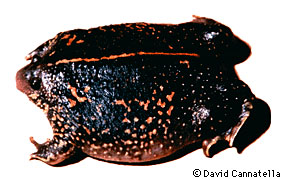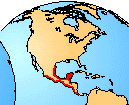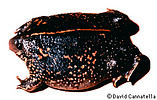Rhinophrynus dorsalis
Mexican Burrowing Toad
David CannatellaIntroduction
Rhinophrynus dorsalis is the only living member of the family Rhinophrynidae. It is one of the strangest of frogs. This animal is highly fossorial (adapted for burrowing) and apparently only comes to the surface to breed, and then only during very heavy rains. The head is small and cone-shaped, and not surprisingly, the skull resembles that of a mole (Spalax). The skin is quite thick, and an early naturalist described the frog (in French) as a bag of bones. It ranges through the southern Rio Grande Valley of Texas to Costa Rica. This frog is 5-7 cm long. There is usually a broad red or orange stripe down the middle of the back. There is a spade, used for digging, on the inner edge of the foot; the first toe is also modified to extend the functional edge of the spade.
Rhinophrynus dorsalis is specialized for eating termites, and the tongue seems to be particularly modified for this activity. Instead of being flipped out over itself, as in most frogs, the tongue is projected straight out of the mouth (Trueb, 1983).
Many small eggs are laid in water, and the tadpoles aggregate and form large schools. They are specialized for filter-feeding on small particles suspended in the water, rather than grazing on algae or eating detritus from the bottom of the pond. Correlated with this behavior, the larvae lack beaks and denticles; they also have paired spiracles like most pipid tadpoles. This type of tadpole (Orton Type 1) is evidence of a close phylogenetic relationship between Rhinophrynidae and Pipidae.
References
Trueb, L. 1983. Feeding specializations of the Mexican burrowing toad, Rhinophynus dorsalis (Anura: Rhinophrynidae). J. Zool., Lond. 199:189-208.
Title Illustrations

| Scientific Name | Rhinophrynus dorsalis |
|---|---|
| Image Use |
 This media file is licensed under the Creative Commons Attribution-ShareAlike License - Version 3.0. This media file is licensed under the Creative Commons Attribution-ShareAlike License - Version 3.0.
|
| Copyright |
© 1995 David Cannatella

|
About This Page
David Cannatella

University of Texas, Austin, Texas, USA
Correspondence regarding this page should be directed to David Cannatella at
Page copyright © 2008 David Cannatella
 Page: Tree of Life
Rhinophrynus dorsalis. Mexican Burrowing Toad.
Authored by
David Cannatella.
The TEXT of this page is licensed under the
Creative Commons Attribution License - Version 3.0. Note that images and other media
featured on this page are each governed by their own license, and they may or may not be available
for reuse. Click on an image or a media link to access the media data window, which provides the
relevant licensing information. For the general terms and conditions of ToL material reuse and
redistribution, please see the Tree of Life Copyright
Policies.
Page: Tree of Life
Rhinophrynus dorsalis. Mexican Burrowing Toad.
Authored by
David Cannatella.
The TEXT of this page is licensed under the
Creative Commons Attribution License - Version 3.0. Note that images and other media
featured on this page are each governed by their own license, and they may or may not be available
for reuse. Click on an image or a media link to access the media data window, which provides the
relevant licensing information. For the general terms and conditions of ToL material reuse and
redistribution, please see the Tree of Life Copyright
Policies.
- First online 25 November 2008
- Content changed 25 November 2008
Citing this page:
Cannatella, David. 2008. Rhinophrynus dorsalis. Mexican Burrowing Toad. Version 25 November 2008 (under construction). http://tolweb.org/Rhinophrynus_dorsalis/17528/2008.11.25 in The Tree of Life Web Project, http://tolweb.org/









 Go to quick links
Go to quick search
Go to navigation for this section of the ToL site
Go to detailed links for the ToL site
Go to quick links
Go to quick search
Go to navigation for this section of the ToL site
Go to detailed links for the ToL site